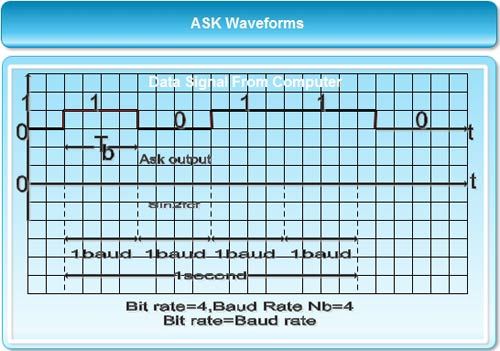Amplitude Shift Keying (ASK) is the simplest type of digital CW modulation. Here the carrier is a sinewave of frequency fc. We can represent the carrier signal mathematically as follows:
ec = sin (2∏fct)
The digital signal from the computer is a unipolar NRZ signal which acts as the modulating signal. The ASK output corresponding to a binary “0” is zero. The ASK output is present only when a binary “I” is to be transmitted. From the waveforms of Fig. we can conclude that the carrier is transmitted when a binary 1 is to be sent and no carrier is transmitted when a binary 0 is to be sent.

We’ll be covering the following topics in this tutorial:
Baud rate (Nb)
• For ASK we use 1 bit (0 or 1) to represent one symbol. So the rate of symbol transmission i.e. the baud rate.
• Nb will be same as bit rate R.
Baud rate = Bit rate
Merits and demerits of ASK
The advantages of using ASK is its simplicity. It is easy to generate and detect. However its disadvantage is that it is very sensitive to noise, therefore it finds limited application in data transmission. It is used at very low bit rates, upto 100 bits/sec.
 Dinesh Thakur holds an B.C.A, MCDBA, MCSD certifications. Dinesh authors the hugely popular
Dinesh Thakur holds an B.C.A, MCDBA, MCSD certifications. Dinesh authors the hugely popular